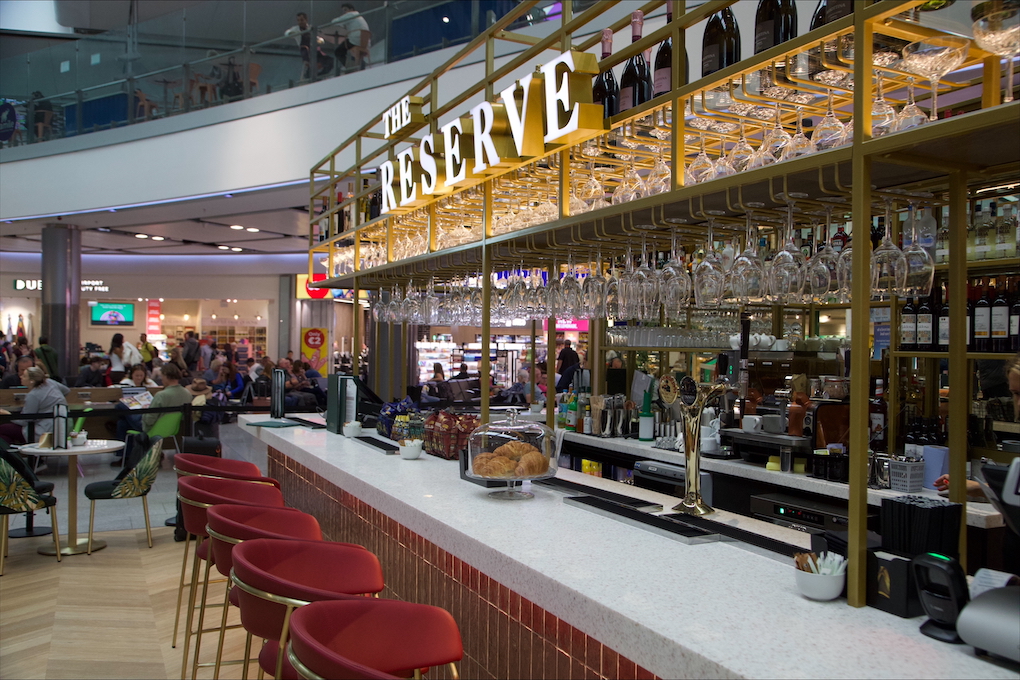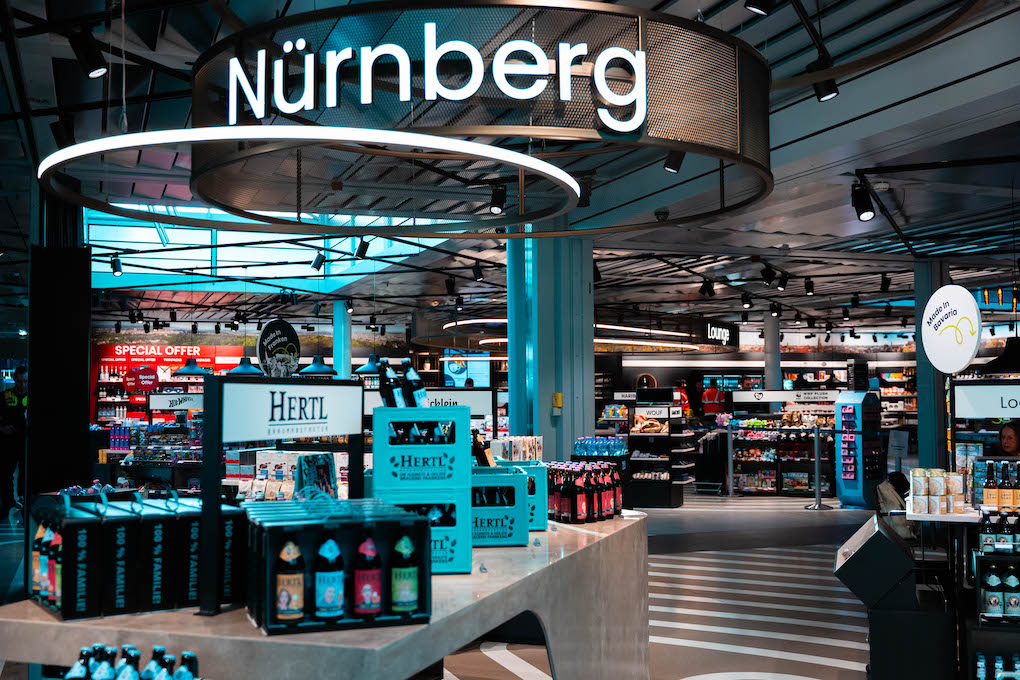 |
Just by Satellite Four, there is a tax-free store called Akihabara. As this satellite will primarily serve flights from Asiana Airlines, Thai Airways, Singapore Airlines and United Airlines, this store seeks to appeal mainly to foreign travellers Photo courtesy of NAA Retailing |
JAPAN. Tokyo Narita’s newly revamped Terminal One South Wing is a story of “firsts” for Japanese duty free. The Hermès and Cartier stores are the largest in global travel retail. The Tiffany boutique is the first in Japanese travel retail. The perfumes and cosmetics store is the first categorized store of its kind in Japanese travel retail.
No wonder then that NAA Retailing Merchandising Director Masa Takatsu is excited about the airport’s – and, as the largest retailer, his company’s – new venture. Throughout our preview tour he points out a “first” or a “largest” at almost every one of the company’s 22 new stores.
The campaign promoting the renovated South Wing used the tag-line “Big Change”. And how apt it was. From check-in procedures to the departure halls, the Narita Airport Authority has, through the new-look South Wing, underlined its ambition to become one of the leading airports in the world.
The South Wing now gathers all Star Alliance airlines under one roof, while the North Wing handles carriers from Sky Team and One World, making transfers smoother.
The 3,500sq m retail area called Narita Nakamise on the third floor of the South Wing also reflects the airport authority’s ambition to expand its non-aeronautical revenues.
And not before time. Even though it is the largest international gateway to Japan, Narita has not seen much commercial development until recent years. Space is a problem at Terminal One’s North Wing. As a result, there has been a heavy reliance on aeronautical fees to drive revenues. Many airlines have complained about the high landing fees.
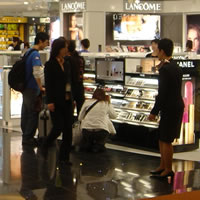 |
The Cosmetics and Perfumery section at FaSoLa. Duty free sales for NAA Retailing cover revenues from cosmetics, perfumes, liquor, tobacco and luxury boutiques Photo courtesy of NAA Retailing |
But all this has changed. The privatization of Narita Airport Authority in 2004 was swiftly followed by the establishment of three joint ventures between the airport authority and leading Japanese airport retailers.
It was all timed to coincide with the renovation of the South Wing, which presented an opportunity for Narita Airport to catch up with the leading airport commercial developments in the rest of the world.
Crucially, the joint ventures meant that the retailer now had more of a say in the retail planning of the airport. Takatsu notes, for example, that one of the major changes at the South Wing is the simplification of check-in and security procedures.
At the North Wing, passengers stand in a queue to get their checked baggage screened before checking-in. After the check-in, they then have to get their carry-on baggage screened, followed by customs and immigration.
Dwell-time suffers as a result. Takatsu says: “It has been said that at the North Wing, passengers have as little as 15-20 minutes to shop.”
At the new South Wing, by contrast, Takatsu believes that the elimination of queues for checked baggage could shave between five and 30 minutes off the time spent by each passenger before they get to the retail area. It’s extra time that they can spend in the shops.
But more importantly, there is also more on offer, and more space dedicated to commercial operations. Besides the 3,500sq m Narita Nakamise space, there are seven stores in the Satellite Five area. Shops are also available landside.
NAA Retailing, as the airport authority’s first joint venture, commands the largest share of retail space at the South Wing. And it is determined to make the best of it.
Duty free sales for NAA Retailing cover revenues from cosmetics, perfumes, liquor, tobacco and luxury boutiques. Tax free products are accounted for in a separate category even though they, like duty free products, are available airside.
The company has set a sales target of Â¥11 billion (US$97 million) for the year April 2006 to March 2007, with big increases expected of duty free sales. The share of duty free sales, which made up just over 17% of the company’s Â¥4.1 billion (US$36 million) turnover in 2005, is expected to grow to more than 50% of total sales in 2006.
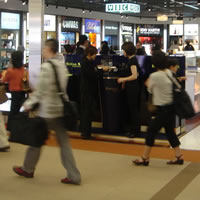 |
FaSoLa’s Liquor and Tobacco section. From check-in procedures to the departure halls, the Narita Airport Authority has, through the new-look South Wing, outlined its ambition to become one of the leading airports in the world Photo courtesy of NAA Retailing |
The large increase expected stems from the fact that the company has, with the opening of the South Wing, more than tripled the number of stores it operates, from eight to 30.
The prime location of NAA Retailing stores is expected to play a part in increasing the revenues as well.
NAA Retailing’s Hermès and Cartier stores are the first that passengers will see when they walk through customs. They are unmissable not just because of their location, but also for their size.
Although Takatsu did not divulge the exact size of the boutiques, he said: “The average size of boutiques at the South Wing is 150sq m, but Hermès and Cartier are special.” A glance at the floor plan shows they are at least twice the size of many of the other boutiques.
The emphasis on luxury boutiques reflects the significance of revenues from luxury stores. To the right of the customs, and leading to Satellite Four, there are Salvatore Ferragamo, Tiffany and a luxury watches stores after Hermès, all operated by NAA Retailing.
To the left after customs and past Cartier, leading to Satellite Five, lie Bvlgari, Coach, Ferragamo, Emporio Armani and Ralph Lauren stores. Bvlgari is operated by ANA Trading Duty Free (ADF), while the rest are operated by the joint venture of JAL/DFS and the Narita Airport Authority.
Takatsu says there is a place for luxury boutiques in Japanese duty free, one that hasn’t always been recognised. He says: “At first I asked, why aren’t Japanese travellers buying Hermès at their destination? But I think there are a few main reasons for this. Here they can shop in yen, the store keepers speak the same language, there are target products for the Japanese, and the atmosphere at the store is different.”
He explains that atmosphere is very important. “For example, the Japanese like to touch things in the store. In some European countries, it is prohibited, and some salespeople will not like it when people touch their products,” he says.
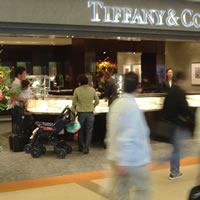 |
The emphasis on luxury boutiques reflects the significance of revenues from luxury stores. To the right of the customs, and leading to Satellite Four, there are Salvatore Ferragamo, Tiffany (pictured) and a luxury watches stores after Hermès, all operated by NAA Retailing Photo courtesy of NAA Retailing |
Another advantage is that buying luxury items in Japanese travel retail is -20% cheaper than in downtown stores. With the Japanese making up some 70% of all travellers at the airport, they are the key customer group for retailers. As a result, many of the stores are designed with this key nationality in mind.
Take the 450sq m cosmetics and perfumery store, for example, which is expected to play on Japanese customers’ love of skincare. It is the first dedicated store of its kind for the category in Japanese travel retail. And even within the store itself, there are firsts and “biggests” – Bobbi Brown has its first counter in Japan travel retail, while the Shiseido counter is the largest in Japan.
Takatsu says: “Each brand brought in a new concept. For example, the YSL logo used in the décor here is different from everywhere else.”
The overall look is light, with black marble used to mark a “pathway” out of the predominantly white flooring. Takatsu calls this the “Canale-Grande”, and points out that it was inspired by the waterways in Venice.
Across from this store, the liquor and tobacco store, at 200sq m, is the biggest in Japan. “Before, the selection for liquor was very small. Now no other shop at Narita has such a large selection of wines,” he says.
At the front of shop, the company is introducing three promotion booths which will be rotated every fortnight. At both the cosmetics and perfume store and the liquor and tobacco stores, the company has introduced the “Fa-So-La Selection”, showcasing best sellers and items on promotion.
Just by Satellite Four, there is a tax-free store called Akihabara. As this satellite will primarily serve flights from Asiana Airlines, Thai Airways, Singapore Airlines and United Airlines, this store seeks to appeal mainly to foreign travellers.
Akihabara is a popular downtown area in Tokyo where tourists head mainly to buy electronics. The concept is one of alternative culture. There are four categories of products in this one store, including electronics, fashion, Japanese food products and Japanese souvenirs.
 |
NAA Retailing’s Hermès (pictured) and Cartier stores are the first that passengers will see when they walk through customs Photo courtesy of NAA Retailing |
Sony has a dynamic booth here, with the newest and latest electronic items. At the fresh produce section, food products will be displayed on an installation resembling a Japanese fishing boat. Japanese everyday items are also popular, with brands such as Kyoto Yojiya occupying significant space.
For passengers who turn left following the customs, they will see the aforementioned luxury stores, as well as two duty free stores by ADF and the NAA/JAL/DFS.
Takatsu notes that while the Satellite Four side of the South Wing will have 65% of all passengers passing through, Satellite Five or the left side of the customs will get passengers who are “rich”, and “willing to spend”. This is because Satellite Five serves ANA flights.
Even though traffic funnelling towards Satellite Five will be served by duty free stores operated by ADF and NAA/JAL/DFS, he says that NAA Retailing will not miss out. Just past the Narita Nakamise area, and right at Satellite Five, it has what it calls the NAA Retailing area. Here it operates all six retail stores, including It’s Demo and Claire’s.
Because ANA passengers will be primarily Japanese, Takatsu says stores such as It’s Demo could appeal to them. “That is a store that can be found at train stations and travellers are familiar with the brand,” he says. Books and magazine are also available at Satellite Five.
For foreigners, there is a gift shop offering a bewildering array of Japanese souvenirs including fans, figurines, keychains, t-shirts and Japanese food products.
Takatsu notes that with the Japanese economy recovering, spending is also increasing at Narita.
Daily sales at the company’s existing 100sq m duty free store – which includes perfumes, cosmetics, tobacco and liquor – at Satellite Three had increased from a modest Â¥300,000 (US$2,600) in November 2004 to about Â¥700,000-800,000 (US$6,100-7,000) now.
“The reasons for this increase are that passenger numbers are up, and our staff have been well-trained for the duty free business,” he says.
The introduction of new products has also helped. The proportion of sales of food product has grown from 0.6% in November 2004 to March 2005 to 9.5% in April and May 2006.
At the same store, while average transaction value fell from Â¥5,522 (US$48) during the same period to Â¥4,867 now (US$43), monthly average sales have increased from Â¥12 million (US$106,000) to Â¥21 million (US$185,000). “That is because the share of low-priced merchandise such as food has expanded,” adds Junichi Nishinoiri, who is NAA Retailing’s Manager for Merchandising.
At the South Wing, the company is looking forward to its best year ever. It has also brought in experienced hands from downtown retail such as Nishinoiri to drive the new business forward.
NAA Retailing is now already turning its attention to another major project at Narita – the renovation of Terminal Two. Takatsu says it is too early to go into details, but reveals that the company will run a “large” duty free store there. If Narita’s impressive new South Wing is any indication, it will be worth waiting for.
MORE STORIES ON TOKYO NARITA
Tokyo Narita unveils new shopping mall, Japanese duty free’s most ambitious project yet – 02/06/2006
Narita Airport Authority previews Nakamise, Japan’s largest airport duty free complex – 29/05/06
JALUX posts +17.7% rise in full year net profits – 10/05/06
NAA Retailing posts +24% growth in duty free sales – 03/05/2006

